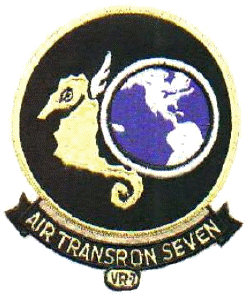In response to increasing military requirements for airlift support in the Pacific, VR-7 attained its third life at Hickam AFB Hawaii, with Capt. S.M. Adams commanding, under the direction of the Pacific Division of MATS. Its core of experienced personnel were from VR-8, recently returned from the Berlin Airlift, also stationed at Hickam and supplemented by additional personnel from throughout the fleet. Both squadrons were equipped with the Douglas R5D Skymaster aircraft, to provide long range airlift capacity to MATS routes in the Pacific. The route included stops at Midway, Johnston, Kwajalein , Wake, Guam and Okinawa Islands and on the Japan and the Philippine Islands. In late 1953, the squadron began the arduous task of transitioning to the state of the art Lockheed Super Constellation R7V-1. This aircraft was ideally suited to long range Pacific service without requiring the need for frequent stops at the lesser Pacific Islands. A complement of 16 aircraft, their flight crews and maintenance personnel and equipment were assigned.
Shortly after their operational clearance, the squadron was chosen to establish and maintain the "Embassy Run" which originated at Travis AFB CA. and traveled westward across the Pacific to American Embassies in Tokyo (Tachikawa AFB) Japan, Manila Clark AFB) Philippines Saigon (Than Son Nhut) Vietnam, Bangkok Thailand, Calcutta India, New Delhi India, Karachi Pakistan and terminating in Dhahran Saudi Arabia. There it met up with the eastern "Embassy Run" which originated at Andrews AFB Washington D.C. and traveled eastward across Europe and Asia to Dhahran Saudi Arabia.
In 1957, the squadron relocated to NAS Moffett Field CA. along with its sister squadron VR-8. It was then designated the "Operations Squadron of Pacific Division of MATS, while VR-8 was designated the "Maintenance Squadron".
In 1963 all 32 Super Constellations were transferred to other units of the Navy and Air Force Reserve and National Guard, and the squadrons transitioned to the C-130E Hercules. This required extensive retraining of maintenance personnel, and the flight crews to undergo "combat aircrew" flight training with the 4442nd combat crew training center at Sewart AFB Tennessee. The squadrons final role was one of combat airlift and supply, which entailed serious training in formation flying, paratroop insertion, low altitude parachute extraction and cargo drop while flying low level radar evasion tactics.
In 1967, after 14 years of operation in the Pacific theater, VR-7 was decommissioned along with other Naval Air Transport squadrons attached to Air Mobility Command. This was last vestige of inter-service operation of the U.S. Navy and U.S. Air Force as a combined command.

